AZ-104 : Microsoft Azure Administrator : Part 07
AZ-104 : Microsoft Azure Administrator : Part 07
-
You have a deployment template named Template1 that is used to deploy 10 Azure web apps.
You need to identify what to deploy before you deploy Template1. The solution must minimize Azure costs.
What should you identify?
- five Azure Application Gateways
- one App Service plan
- 10 App Service plans
- one Azure Traffic Manager
- one Azure Application Gateway
Explanation:You create Azure web apps in an App Service plan.
-
HOTSPOT
You plan to deploy an Azure container instance by using the following Azure Resource Manager template.

AZ-104 Part 07 Q02 119 Use the drop-down menus to select the answer choice that completes each statement based on the information presented in the template.

AZ-104 Part 07 Q02 120 Question 
AZ-104 Part 07 Q02 120 Answer -
You have an Azure subscription that contains a virtual machine named VM1. VM1 hosts a line-of-business application that is available 24 hours a day. VM1 has one network interface and one managed disk. VM1 uses the D4s v3 size.
You plan to make the following changes to VM1:
– Change the size to D8s v3.
– Add a 500-GB managed disk.
– Add the Puppet Agent extension.
– Enable Desired State Configuration Management.Which change will cause downtime for VM1?
- Enable Desired State Configuration Management
- Add a 500-GB managed disk
- Change the size to D8s v3
- Add the Puppet Agent extension
Explanation:While resizing the VM it must be in a stopped state.
-
You have an app named App1 that runs on an Azure web app named webapp1.
The developers at your company upload an update of App1 to a Git repository named Git1.
Webapp1 has the deployment slots shown in the following table.

AZ-104 Part 07 Q04 121 You need to ensure that the App1 update is tested before the update is made available to users.
Which two actions should you perform? Each correct answer presents part of the solution.
- Swap the slots
- Deploy the App1 update to webapp1-prod, and then test the update
- Stop webapp1-prod
- Deploy the App1 update to webapp1-test, and then test the update
- Stop webapp1-test
-
You have an Azure subscription named Subscription1 that has the following providers registered:
– Authorization
– Automation
– Resources
– Compute
– KeyVault
– Network
– Storage
– Billing
– WebSubscription1 contains an Azure virtual machine named VM1 that has the following configurations:
– Private IP address: 10.0.0.4 (dynamic)
– Network security group (NSG): NSG1
– Public IP address: None
– Availability set: AVSet
– Subnet: 10.0.0.0/24
– Managed disks: No
– Location: East USYou need to record all the successful and failed connection attempts to VM1.
Which three actions should you perform? Each correct answer presents part of the solution.
NOTE: Each correct selection is worth one point.
- Enable Azure Network Watcher in the East US Azure region.
- Add an Azure Network Watcher connection monitor.
- Register the MicrosoftLogAnalytics provider.
- Create an Azure Storage account.
- Register the Microsoft.Insights resource provider.
- Enable Azure Network Watcher flow logs.
Explanation:You can log network traffic that flows through an NSG with Network Watcher’s NSG flow log capability.
In the Azure portal, enable Network Watcher
Register Insights provider. NSG flow logging requires the Microsoft.Insights provider.
Enable NSG flow log. NSG flow log data is written to an Azure Storage account, Subscription1 has storage. -
You need to deploy an Azure virtual machine scale set that contains five instances as quickly as possible.
What should you do?
- Deploy five virtual machines. Modify the Availability Zones settings for each virtual machine.
- Deploy five virtual machines. Modify the Size setting for each virtual machine.
- Deploy one virtual machine scale set that is set to VM (virtual machines) orchestration mode.
- Deploy one virtual machine scale set that is set to ScaleSetVM orchestration mode.
-
You plan to create the Azure web apps shown in the following table.
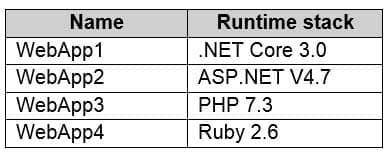
AZ-104 Part 07 Q07 122 What is the minimum number of App Service plans you should create for the web apps?
- 1
- 2
- 3
- 4
-
HOTSPOT
You have a pay-as-you-go Azure subscription that contains the virtual machines shown in the following table.

AZ-104 Part 07 Q08 123 You create the budget shown in the following exhibit.
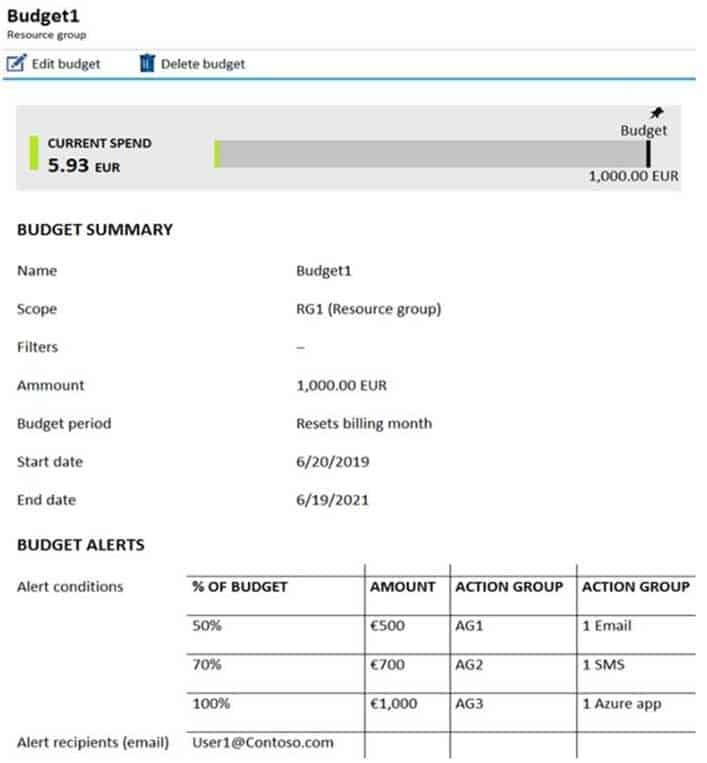
AZ-104 Part 07 Q08 124 The AG1 action group contains a user named admin@contoso.com only.
Use the drop-down menus to select the answer choice that completes each statement based on the information presented in the graphic.

AZ-104 Part 07 Q08 125 Question 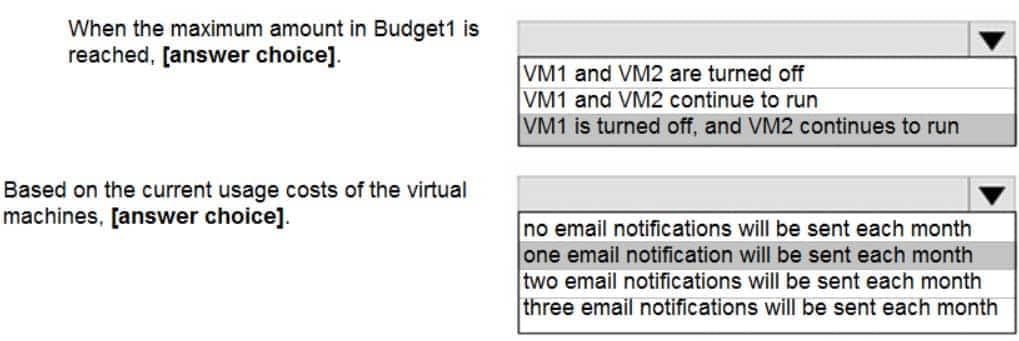
AZ-104 Part 07 Q08 125 Answer Explanation:
Box 1: VM1 is turned off, and VM2 continues to run
The budget alerts are for Resource Group RG1, which include VM1, but not VM2.Box 2: one email notification will be sent each month.
Budget alerts for Resource Group RG1, which include VM1, but not VM2.VM1 consumes 20 Euro/day. The 50%, 500 Euro limit, will be reached in 25 days, and an email will be sent.The 70% and 100% alert conditions will not be reached within a month, and they don’t trigger email actions anyway.
Credit alerts: Credit alerts are generated automatically at 90% and at 100% of your Azure credit balance. Whenever an alert is generated, it’s reflected in cost alerts and in the email sent to the account owners. 90% and 100% will not be reached though.
-
Note: This question is part of a series of questions that present the same scenario. Each question in the series contains a unique solution that might meet the stated goals. Some question sets might have more than one correct solution, while others might not have a correct solution.
After you answer a question in this section, you will NOT be able to return to it. As a result, these questions will not appear in the review screen.
You have an Azure subscription named Subscription1. Subscription1 contains a resource group named RG1. RG1 contains resources that were deployed by using templates.
You need to view the date and time when the resources were created in RG1.
Solution: From the Subscriptions blade, you select the subscription, and then click Programmatic deployment.
Does this meet the goal?
- Yes
- No
Explanation:From the RG1 blade, click Deployments. You see a history of deployment for the resource group.
-
Note: This question is part of a series of questions that present the same scenario. Each question in the series contains a unique solution that might meet the stated goals. Some question sets might have more than one correct solution, while others might not have a correct solution.
After you answer a question in this section, you will NOT be able to return to it. As a result, these questions will not appear in the review screen.
You have an Azure subscription that contains the resources shown in the following table.

AZ-104 Part 07 Q10 126 VM1 connects to VNET1.
You need to connect VM1 to VNET2.
Solution: You create a new network interface, and then you add the network interface to VM1.
Does this meet the goal?
- Yes
- No
Explanation:
You should delete VM1. You recreate VM1, and then you add the network interface for VM1.Note: When you create an Azure virtual machine (VM), you must create a virtual network (VNet) or use an existing VNet. You can change the subnet a VM is connected to after it’s created, but you cannot change the VNet.
-
You have an Azure Active Directory (Azure AD) tenant named adatum.com that contains the users shown in the following table.
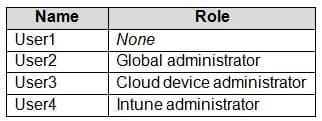
AZ-104 Part 07 Q11 127 Adatum.com has the following configurations:
– Users may join devices to Azure AD is set to User1.
– Additional local administrators on Azure AD joined devices is set to None.You deploy Windows 10 to a computer named Computer1. User1 joins Computer1 to adatum.com.
You need to identify the local Administrator group membership on Computer1.
Which users are members of the local Administrators group?
- User1 only
- User2 only
- User1 and User2 only
- User1, User2, and User3 only
- User1, User2, User3, and User4
Explanation:
Users may join devices to Azure AD – This setting enables you to select the users who can register their devices as Azure AD joined devices. The default is All.Additional local administrators on Azure AD joined devices – You can select the users that are granted local administrator rights on a device. Users added here are added to the Device Administrators role in Azure AD. Global administrators, here User2, in Azure AD and device owners are granted local administrator rights by default.
-
HOTSPOT
You have Azure subscriptions named Subscription1 and Subscription2.
Subscription1 has following resource groups:

AZ-104 Part 07 Q12 128 RG1 includes a web app named App1 in the West Europe location.
Subscription2 contains the following resource groups:

AZ-104 Part 07 Q12 129 For each of the following statements, select Yes if the statement is true. Otherwise, select No.
NOTE: Each correct selection is worth one point.

AZ-104 Part 07 Q12 130 Question 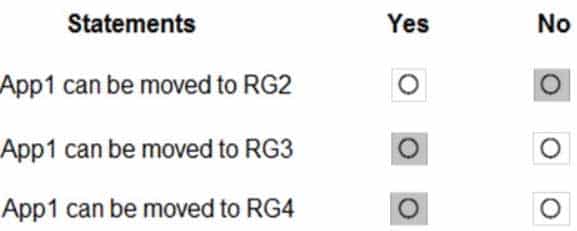
AZ-104 Part 07 Q12 130 Answer Explanation:
Box 1: No
RG2 is read only. ReadOnly means authorized users can read a resource, but they cannot delete or update the resource.Box 2: Yes
Box 3: Yes
Note:
App Service resources are region-specific and cannot be moved directly across regions. You can move the App Service resource by creating a copy of your existing App Service resource in the target region, then move your content over to the new app. You can then delete the source app and App Service plan.To make copying your app easier, you can clone an individual App Service app into an App Service plan in another region.
-
HOTSPOT
You have an Azure subscription named Subscription1 that contains the following resource group:
– Name: RG1
– Region: West US
– Tag: “tag1”: “value1”You assign an Azure policy named Policy1 to Subscription1 by using the following configurations:– Exclusions: None
– Policy definition: Append a tag and its value to resources
– Assignment name: Policy1
– Parameters:
– Tag name: tag2
– Tag value: value2After Policy1 is assigned, you create a storage account that has the following configuration:- Name: storage1
– Location: West US
– Resource group: RG1
– Tags: “tag3”: “value3”You need to identify which tags are assigned to each resource.What should you identify? To answer, select the appropriate options in the answer area.NOTE: Each correct selection is worth one point.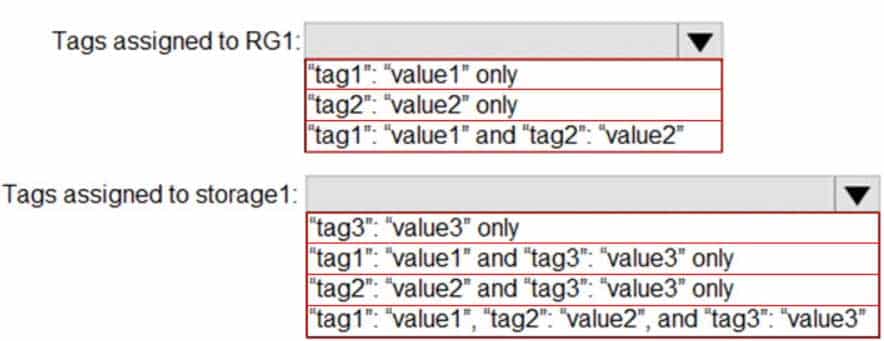
AZ-104 Part 07 Q13 131 Question 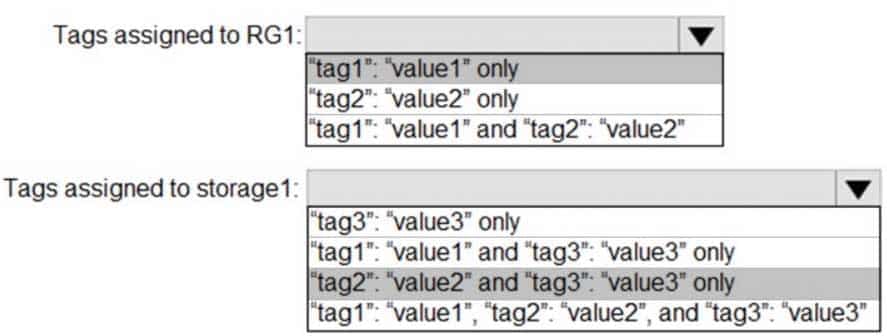
AZ-104 Part 07 Q13 131 Answer Explanation:
Box 1: “tag1”: “value1” only
Box 2: “tag2”: “value2” and “tag3”: “value3” only
Tags applied to the resource group are not inherited by the resources in that resource group.
-
HOTSPOT
You have an Azure subscription named Subscription1.
In Subscription1, you create an alert rule named Alert1.
The Alert1 action group is configured as shown in the following exhibit.

AZ-104 Part 07 Q14 132 Alert1 alert criteria triggered every minute.
Use the drop-down menus to select the answer choice that completes each statement based on the information presented in the graphic.
NOTE: Each correct selection is worth one point.
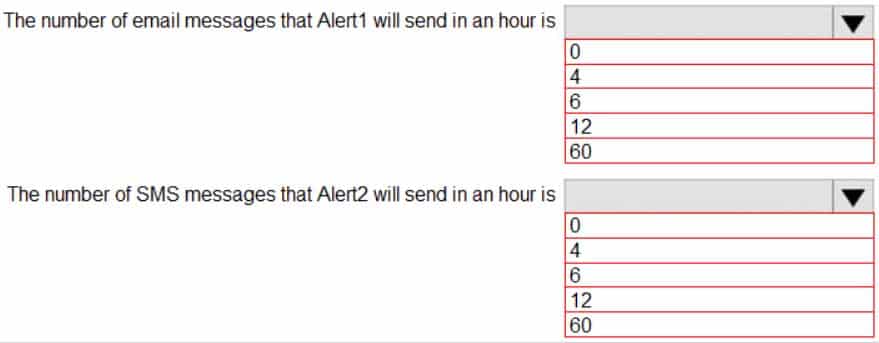
AZ-104 Part 07 Q14 133 Question 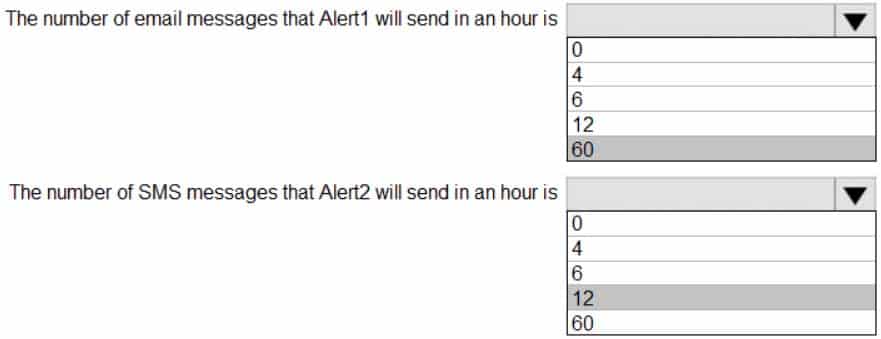
AZ-104 Part 07 Q14 133 Answer Explanation:
Box 1: 60
One alert per minute will trigger one email per minute.Box 2: 12
No more than 1 SMS every 5 minutes can be send, which equals 12 per hour.Note: Rate limiting is a suspension of notifications that occurs when too many are sent to a particular phone number, email address or device. Rate limiting ensures that alerts are manageable and actionable.
The rate limit thresholds are:
– SMS: No more than 1 SMS every 5 minutes.
– Voice: No more than 1 Voice call every 5 minutes.
– Email: No more than 100 emails in an hour.
– Other actions are not rate limited. -
You have an Azure subscription named Subscription1 that contains the resources shown in the following table.

AZ-104 Part 07 Q15 134 You create virtual machines in Subscription1 as shown in the following table.

AZ-104 Part 07 Q15 135 You plan to use Vault1 for the backup of as many virtual machines as possible.
Which virtual machines can be backed up to Vault1?
- VM1 only
- VM3 and VMC only
- VM1, VM2, VM3, VMA, VMB, and VMC
- VM1, VM3, VMA, and VMC only
- VM1 and VM3 only
Explanation:To create a vault to protect virtual machines, the vault must be in the same region as the virtual machines. If you have virtual machines in several regions, create a Recovery Services vault in each region.
-
You have an Azure Kubernetes Service (AKS) cluster named AKS1.
You need to configure cluster autoscaler for AKS1.
Which two tools should you use? Each correct answer presents a complete solution.
NOTE: Each correct selection is worth one point.
- the kubectl command
- the az aks command
- the Set-AzVm cmdlet
- the Azure portal
- the Set-AzAks cmdlet
Explanation:
A: The following example uses the kubectl autoscale command to autoscale the number of pods in the azure-vote-front deployment. If average CPU utilization across all pods exceeds 50% of their requested usage, the autoscaler increases the pods up to a maximum of 10 instances. A minimum of 3 instances is then defined for the deployment:kubectl autoscale deployment azure-vote-front –cpu-percent=50 –min=3 –max=10
B: Use the az aks update command to enable and configure the cluster autoscaler on the node pool for the existing cluster.
-
You create the following resources in an Azure subscription:
– An Azure Container Registry instance named Registry1
– An Azure Kubernetes Service (AKS) cluster named Cluster1You create a container image named App1 on your administrative workstation.
You need to deploy App1 to Cluster1.
What should you do first?
- Run the docker push command.
- Create an App Service plan.
- Run the az acr build command.
- Run the az aks create command.
Explanation:
You should sign in and push a container image to Container Registry.
Run the az acr build command to build and push the container image.az acr build \
–image contoso-website \
–registry $ACR_NAME \
–file Dockerfile . -
You have an Azure subscription that contains the resources shown in the following table.

AZ-104 Part 07 Q18 136 You need to configure a proximity placement group for VMSS1.
Which proximity placement groups should you use?
- Proximity2 only
- Proximity1, Proximity2, and Proximity3
- Proximity1 only
- Proximity1 and Proximity3 only
Explanation:Resource Group location of VMSS1 is the RG2 location, which is West US.
Only Proximity2, which also in RG2, is location in West US -
Note: This question is part of a series of questions that present the same scenario. Each question in the series contains a unique solution that might meet the stated goals. Some question sets might have more than one correct solution, while others might not have a correct solution.
After you answer a question in this section, you will NOT be able to return to it. As a result, these questions will not appear in the review screen.
You have an Azure subscription named Subscription1. Subscription1 contains a resource group named RG1. RG1 contains resources that were deployed by using templates.
You need to view the date and time when the resources were created in RG1.
Solution: From the Subscriptions blade, you select the subscription, and then click Resource providers.
Does this meet the goal?
- Yes
- No
-
Note: This question is part of a series of questions that present the same scenario. Each question in the series contains a unique solution that might meet the stated goals. Some question sets might have more than one correct solution, while others might not have a correct solution.
After you answer a question in this section, you will NOT be able to return to it. As a result, these questions will not appear in the review screen.
You have an Azure subscription named Subscription1. Subscription1 contains a resource group named RG1. RG1 contains resources that were deployed by using templates.
You need to view the date and time when the resources were created in RG1.
Solution: From the RG1 blade, you click Automation script.
Does this meet the goal?
- Yes
- No
Explanation:From the RG1 blade, click Deployments. You see a history of deployment for the resource group.